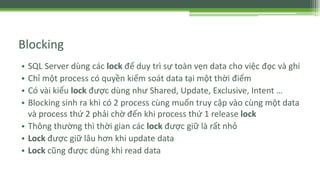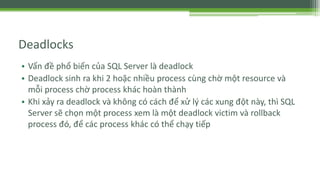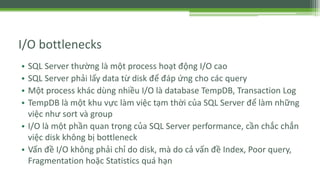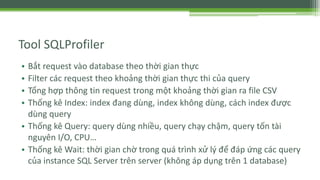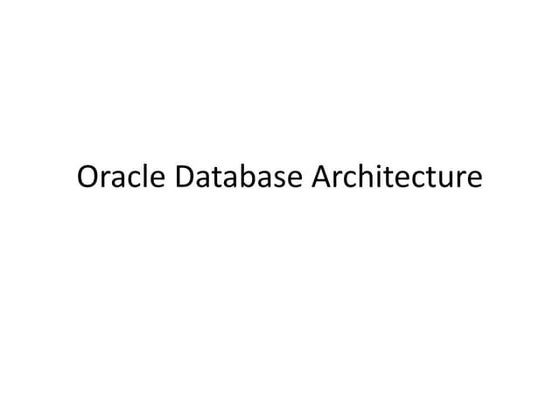Monitor v├Ā tß╗æi Ų░u sql server
- 1. Monitor v├Ā tß╗æi Ų░u SQL Server
- 2. Introduction ŌĆó C├Īc yß║┐u tß╗æ cß║¦n xem x├®t khi tß╗æi Ų░u SQL. ŌĆó Tool monitor SQL. ŌĆó Tß╗æi Ų░u SQL query d├╣ng Database Engine Tuning Advisor.
- 3. C├Īc yß║┐u tß╗æ cß║¦n xem x├®t khi tß╗æi Ų░u SQL ŌĆó Blocking ŌĆó Deadlocks ŌĆó I/O bottlenecks ŌĆó Missing and Unused indexes ŌĆó Statistics ŌĆó Wait stats ŌĆó Fragmentation ŌĆó Poor query plans DBA Developer
- 4. Blocking ŌĆó SQL Server d├╣ng c├Īc lock ─æß╗ā duy tr├¼ sß╗▒ to├Ān vß║╣n data cho viß╗ćc ─æß╗Źc v├Ā ghi ŌĆó Chß╗ē mß╗Öt process c├│ quyß╗ün kiß╗ām so├Īt data tß║Īi mß╗Öt thß╗Øi ─æiß╗ām ŌĆó C├│ v├Āi kiß╗āu lock ─æŲ░ß╗Żc d├╣ng nhŲ░ Shared, Update, Exclusive, Intent ŌĆ” ŌĆó Blocking sinh ra khi c├│ 2 process c├╣ng muß╗æn truy cß║Łp v├Āo c├╣ng mß╗Öt data v├Ā process thß╗® 2 phß║Żi chß╗Ø ─æß║┐n khi process thß╗® 1 release lock ŌĆó Th├┤ng thŲ░ß╗Øng th├¼ thß╗Øi gian c├Īc lock ─æŲ░ß╗Żc giß╗» l├Ā rß║źt nhß╗Å ŌĆó Lock ─æŲ░ß╗Żc giß╗» l├óu hŲĪn khi update data ŌĆó Lock c┼®ng ─æŲ░ß╗Żc d├╣ng khi read data
- 5. Deadlocks ŌĆó Vß║źn ─æß╗ü phß╗Ģ biß║┐n cß╗¦a SQL Server l├Ā deadlock ŌĆó Deadlock sinh ra khi 2 hoß║Ęc nhiß╗üu process c├╣ng chß╗Ø mß╗Öt resource v├Ā mß╗Śi process chß╗Ø process kh├Īc ho├Ān th├Ānh ŌĆó Khi xß║Ży ra deadlock v├Ā kh├┤ng c├│ c├Īch ─æß╗ā xß╗Ł l├Į c├Īc xung ─æß╗Öt n├Āy, th├¼ SQL Server sß║Į chß╗Źn mß╗Öt process xem l├Ā mß╗Öt deadlock victim v├Ā rollback process ─æ├│, ─æß╗ā c├Īc process kh├Īc c├│ thß╗ā chß║Īy tiß║┐p
- 6. I/O bottlenecks ŌĆó SQL Server thŲ░ß╗Øng l├Ā mß╗Öt process hoß║Īt ─æß╗Öng I/O cao ŌĆó SQL Server phß║Żi lß║źy data tß╗½ disk ─æß╗ā ─æ├Īp ß╗®ng cho c├Īc query ŌĆó Mß╗Öt process kh├Īc d├╣ng nhiß╗üu I/O l├Ā database TempDB, Transaction Log ŌĆó TempDB l├Ā mß╗Öt khu vß╗▒c l├Ām viß╗ćc tß║Īm thß╗Øi cß╗¦a SQL Server ─æß╗ā l├Ām nhß╗»ng viß╗ćc nhŲ░ sort v├Ā group ŌĆó I/O l├Ā mß╗Öt phß║¦n quan trß╗Źng cß╗¦a SQL Server performance, cß║¦n chß║»c chß║»n viß╗ćc disk kh├┤ng bß╗ŗ bottleneck ŌĆó Vß║źn ─æß╗ü I/O kh├┤ng phß║Żi chß╗ē do disk, m├Ā do cß║Ż vß║źn ─æß╗ü Index, Poor query, Fragmentation hoß║Ęc Statistics qu├Ī hß║Īn
- 7. Index ŌĆó Index l├Ā yß║┐u tß╗æ quan trß╗Źng trong viß╗ćc tß╗æi Ų░u query ŌĆó C├Īc kiß╗āu index Ō¢½ Non-Clustered Ō¢½ Clustered Ō¢½ Covering Ō¢½ Filtered ŌĆó C├Īc viß╗ćc l├Ām dß║½n ─æß║┐n giß║Żm tß╗æi Ų░u query v├Ā database Ō¢½ Kh├┤ng tß║Īo Index Ō¢½ Tß║Īo qu├Ī nhiß╗üu Index tr├¬n mß╗Öt table Ō¢½ Index sai column Ō¢½ Kh├┤ng c├│ kß║┐ hoß║Īch bß║Żo tr├¼ Index
- 8. Statistics ŌĆó Statistic l├Ā object chß╗®a c├Īc th├┤ng tin thß╗æng k├¬ vß╗ü sß╗▒ ph├ón t├Īn dß╗» liß╗ću trong mß╗Öt hoß║Ęc nhiß╗üu column cß╗¦a mß╗Öt table hoß║Ęc index view. ŌĆó Statistic chß╗®a th├┤ng tin vß╗ü index ŌĆó Query optimizer d├╣ng statistic ─æß╗ā tß║Īo query plan gi├║p t─āng performance cß╗¦a query ŌĆó Mß╗Öt v├Āi trŲ░ß╗Øng hß╗Żp, cß║¦n tß║Īo th├¬m statistic hoß║Ęc thay ─æß╗Ģi query cho kß║┐t quß║Ż tß╗æt nhß║źt ŌĆó Statistic ─æŲ░ß╗Żc create khi : Ō¢½ Query optimizer tß║Īo statistic cho c├Īc index cß╗¦a table hoß║Ęc view khi index ─æŲ░ß╗Żc tß║Īo Ō¢½ Query optimizer tß║Īo statistic cho c├Īc column ─æŲĪn khi AUTO_CREATE_STATISTICS is on ŌĆó Statistic ─æŲ░ß╗Żc update khi : Ō¢½ Query optimizer x├Īc ─æß╗ŗnh khi n├Āo statistic c├│ thß╗ā qu├Ī hß║Īn v├Ā sau ─æ├│ update ch├║ng khi cß║¦n Ō¢½ AUTO_UPDATE_STATISTICS is on Ō¢½ D├╣ng c├óu lß╗ćnh UPDATE STATISTICS hoß║Ęc store procedure sp_updatestats
- 9. Fragmentation ŌĆó Sß╗▒ ph├ón mß║Żnh l├Ā sß╗▒ lŲ░u trß╗» data kh├┤ng li├¬n tß╗źc tr├¬n disk ŌĆó Internal Fragmentation Ō¢½ Record lŲ░u trß╗» kh├┤ng ti├¬n tß╗źc trong page Ō¢½ Xuß║źt hiß╗ćn c├Īc kh├┤ng gian kh├┤ng ─æŲ░ß╗Żc d├╣ng giß╗»a c├Īc record trong page Ō¢½ Sinh ra khi d├╣ng c├Īc lß╗ćnh INSERT, UPDATE, DELETE ŌĆó External Fragmentation Ō¢½ C├Īc page ─æŲ░ß╗Żc lŲ░u trß╗» vß║Łt l├Į trong mß╗Öt phß║Īm vi (Extent) Ō¢½ C├Īc Extent lŲ░u trß╗» vß║Łt l├Į kh├┤ng li├¬n tß╗źc tr├¬n disk ŌĆó Logical Fragmentation Ō¢½ C├Īc page index duy tr├¼ sß╗▒ sß║»p xß║┐p logic cß╗¦a page trong extent Ō¢½ Do Page split m├Ā c├Īc page bß╗ŗ mß║źt trß║Łt tß╗▒
- 10. Wait stats ŌĆó ─ÉŲ░a ra th├┤ng tin vß╗ü thß╗Øi gian chß╗Ø viß╗ćc thß╗▒c thi cß╗¦a c├Īc thread ─æß╗æi vß╗øi c├Īc t├Āi nguy├¬n cß╗¦a hß╗ć thß╗æng ŌĆó C├│ rß║źt nhiß╗üu c├Īc th├┤ng sß╗æ kh├Īc nhau vß╗ü c├Īc loß║Īi t├Āi nguy├¬n cß╗¦a hß╗ć thß╗æng Ō¢½ PAGEIOLATCH_SH xß║Ży ra khi mß╗Öt thead chß╗Ø ─æß╗Żi tr├¬n mß╗Öt chß╗æt cho mß╗Öt bß╗Ö ─æß╗ćm ─æ├│ l├Ā trong mß╗Öt y├¬u cß║¦u I/O. Y├¬u cß║¦u chß╗æt l├Ā ß╗¤ chß║┐ ─æß╗Ö Shared. Long waits c├│ thß╗ā chß╗ē ra vß║źn ─æß╗ü vß╗øi disk Ō¢½ OLEDB chß╗Ø mß╗Öt giao tiß║┐p d├╣ng OLEDB nhŲ░ linked server Ō¢½ CXPACKET xß║Ży ra vß╗øi c├Īc truy vß║źn song song Ō¢½ ASYNC_NETWORK_IO xß║Ży ra khi SQL Server chß╗Ø mß╗Öt client lß║źy dß╗» liß╗ću ŌĆó Dß╗▒a v├Āo c├Īc th├┤ng sß╗æ tr├¬n ─æß╗ā ─æiß╗üu tra nguy├¬n nh├ón g├óy ra vß║źn ─æß╗ü vß╗ü hiß╗ću n─āng cß╗¦a hß╗ć thß╗æng
- 11. Poor query plan ŌĆó Tß║Īo c├óu lß╗ćnh truy vß║źn dß╗» liß╗ću kh├┤ng tß╗æi Ų░u Ō¢½ Lß║źy ra nhß╗»ng column kh├┤ng cß║¦n d├╣ng Ō¢½ T├Łnh to├Īn dß╗» liß╗ću dß╗▒a tr├¬n c├Īc column trong c├óu lß╗ćnh JOIN v├Ā WHERE Ō¢½ D├╣ng sub-query Ō¢½ D├╣ng con trß╗Å Ō¢½ ŌĆ” Ō¢½ Index kh├┤ng c├│ hoß║Ęc sai hoß║Ęc kh├┤ng ─æŲ░ß╗Żc bß║Żo tr├¼ Ō¢½ Statistic kh├┤ng ─æŲ░ß╗Żc update Ō¢½ ŌĆ” Developer DBA
- 12. Tool SQLProfiler ŌĆó Bß║»t request v├Āo database theo thß╗Øi gian thß╗▒c ŌĆó Filter c├Īc request theo khoß║Żng thß╗Øi gian thß╗▒c thi cß╗¦a query ŌĆó Tß╗Ģng hß╗Żp th├┤ng tin request trong mß╗Öt khoß║Żng thß╗Øi gian ra file CSV ŌĆó Thß╗æng k├¬ Index: index ─æang d├╣ng, index kh├┤ng d├╣ng, c├Īch index ─æŲ░ß╗Żc d├╣ng query ŌĆó Thß╗æng k├¬ Query: query d├╣ng nhiß╗üu, query chß║Īy chß║Łm, query tß╗æn t├Āi nguy├¬n I/O, CPUŌĆ” ŌĆó Thß╗æng k├¬ Wait: thß╗Øi gian chß╗Ø trong qu├Ī tr├¼nh xß╗Ł l├Į ─æß╗ā ─æ├Īp ß╗®ng c├Īc query cß╗¦a instance SQL Server tr├¬n server (kh├┤ng ├Īp dß╗źng tr├¬n 1 database)
- 13. Chß╗Źn server cß║¦n theo d├Ąi Click ─æß╗ā khß╗¤i chß║Īy
- 15. Sß╗æ lß║¦n query d├╣ng kiß╗āu seek tr├¬n index Seek l├Ā kiß╗āu nhanh nhß║źt ─æß╗ā access data Sß╗æ lß║¦n query d├╣ng kiß╗āu scan tr├¬n index Scan l├Ā khi nhiß╗üu row data phß║Żi ─æŲ░ß╗Żc t├¼m kiß║┐m Sß╗æ lß║¦n query tß╗½ mß╗Öt clusterd index hoß║Ęc heap Sß╗æ lß║¦n index ─æŲ░ß╗Żc update do sß╗▒ thay ─æß╗Ģi dß╗» liß╗ću
- 16. Sß╗▒ ph├ón mß║Żnh cß╗¦a index theo % Reorganize index khi sß╗▒ ph├ón mß║Żnh nß║▒m trong khoß║Żng tß╗½ 5% - 30% Rebuild index khi sß╗▒ ph├ón mß║Żnh tr├¬n 30%
- 17. ─É├óy l├Ā nhß╗»ng index kh├┤ng d├╣ng, c├│ thß╗ā ─æŲ░a ra table cß╗¦a index ─æ├│ c┼®ng kh├┤ng ─æŲ░ß╗Żc d├╣ng => Xem x├®t x├│a
- 18. Thß╗Øi gian query plan ─æŲ░ß╗Żc bi├¬n dß╗ŗch Thß╗Øi gian gß║¦n nhß║źt m├Ā query chß║Īy Sß╗æ lß║¦n chß║Īy tß╗½ khi creation_time ─æß║┐n last_execuation_time Nß╗Öi dung c├óu lß╗ćnh query
- 19. Thß╗æng k├¬ vß╗ü thß╗Øi gian chß╗Ø cß╗¦a c├Īc hoß║Īt ─æß╗Öng cß╗¦a cß║Ż hß╗ć thß╗æng SQL Server, nhŲ░ I/O, Network, OLEDBŌĆ”
- 20. Th├┤ng tin index trong Execution plan ŌĆó Ctrl + M trong SSMS ─æß╗ā bß║Łt t├Łnh n─āng execution plan v├Ā chß║Īy query Query dß╗» liß╗ću trong table kh├┤ng c├│ Index Query dß╗» liß╗ću trong table tr├¬n index Nonclustered Query dß╗» liß╗ću trong table tr├¬n index Clustered Query dß╗» liß╗ću trong table tr├¬n index Non-Clustered nhŲ░ng cß║¦n th├¬m dß╗» liß╗ću tß╗½ mß╗Öt index Clusterd Query dß╗» liß╗ću trong table tr├¬n index Non-Clustered nhŲ░ng cß║¦n th├¬m dß╗» liß╗ću v├Ā table ko c├│ index Clusterd Estimated Subtree Cost l├Ā gi├Ī trß╗ŗ tß╗Ģng chi ph├Ł cß╗¦a query optimizer cho viß╗ćc chß║Īy query v├Ā tß║źt cß║Ż c├Īc hoß║Īt ─æß╗Öng trŲ░ß╗øc n├│ tr├¬n c├╣ng subtree. Gi├Ī trß╗ŗ nhß╗Å ngh─®a l├Ā n├│ cß║¦n ├Łt resource
- 21. Tß╗æi Ų░u query d├╣ng Database Engine Tuning Advisor ŌĆó Xem chi tiß║┐t tß║Īi ─æ├óy.
- 22. Sß╗▒ sai kh├Īc execution plan v├Ā thß╗Øi gian thß╗▒c thi trong store procedure ŌĆó Nguy├¬n nh├ón Ō¢½ Constant value Ō¢½ Parameter sniffing ŌĆó C├Īch khß║»c phß╗źc Ō¢½ RECOMPILE Ō¢½ OPTIMISE FOR UNKNOWN (tß╗½ phi├¬n bß║Żn SQL Server 2008) Ō¢½ Parameter masking
Editor's Notes
- #4: Xem thêm https://www.mssqltips.com/sqlservertutorial/276/sql-server-performance-tuning-and-monitoring-tutorial/
- #5: Overview Khi c├Īc Lock ─æŲ░ß╗Żc giß╗» trong khoß║Żng thß╗Øi gian th├¼ ch├║ng sinh ra blocking, c├│ ngh─®a 1 process phß║Żi chß╗Ø cho ─æß║┐n khi process kh├Īc ho├Ān th├Ānh v├Ā release lock Giß╗æng vß╗øi deadlocking khi m├Ā 2 process c├╣ng chß╗Ø d├╣ng mß╗Öt resource Kh├┤ng giß╗æng vß╗øi deadlocking v├¼ blocking ─æŲ░ß╗Żc xß╗Ł l├Į ngay khi process release resource Explanation Khi dß╗» liß╗ću ─æŲ░ß╗Żc update th├¼ mß╗Öt Update lock ─æŲ░ß╗Żc d├╣ng v├Ā khi dß╗» liß╗ću ─æŲ░ß╗Żc ─æß╗Źc th├¼ mß╗Öt Shared lock ─æŲ░ß╗Żc dung Update lock sß║Į tß║Īo mß╗Öt Exclusive lock tr├¬n dß╗» liß╗ću m├Ā process d├╣ng Shared lock cho ph├®p c├Īc process kh├Īc d├╣ng Shared lock ─æß╗ā truy cß║Łp dß╗» liß╗ću Khi m├Ā 2 process c├╣ng truy cß║Łp v├Āo c├╣ng mß╗Öt dß╗» liß╗ću th├¼ ─æ├│ l├Ā khi locking v├Ā blocking xß║Ży ra Xem th├¬m https://www.mssqltips.com/sqlservertutorial/253/troubleshooting-blocking/
- #6: Mß║Ęc ─æß╗ŗnh khi deadlock xß║Ży ra, ß╗®ng dß╗źng cß╗¦a bß║Īn c├│ thß╗ā bß║»t v├Ā handle error, nhŲ░ng trong SQL Server Error Log hoß║Ęc Window Event Log sß║Į kh├┤ng bß║»t lß╗Śi n├Āy Xem th├¬m https://www.mssqltips.com/sqlservertutorial/252/tracing-a-sql-server-deadlock/
- #7: Overview Hß║¦u hß║┐t c├Īc trŲ░ß╗Øng hß╗Żp Database c├│ dung lŲ░ß╗Żng lß╗øn hŲĪn dung lŲ░ß╗Żng cß╗¦a bß╗Ö nhß╗ø m├Īy t├Łnh ─æŲ░ß╗Żc c├Āi ─æß║Ęt v├Ā do ─æ├│ SQL Server phß║Żi lß║źy data tß╗½ disk ─æß╗ā ─æ├Īp ß╗®ng cho c├Īc query Do data trong database l├Ā lu├┤n thay ─æß╗Ģi, c├Īc thay ─æß╗Ģi n├Āy cß║¦n ghi v├Āo disk TempDB c┼®ng lŲ░u tr├¬n disk do vß║Ły sß╗▒ phß╗ź thuß╗Öc v├Āo bao nhi├¬u object tß║Īm ─æŲ░ß╗Żc tß║Īo trong database n├Āy c├│ thß╗ā l├Ā hŲĪn cß║Ż user database I/O l├Ā mß╗Öt phß║¦n quan trß╗Źng cß╗¦a SQL Server performance, cß║¦n chß║»c chß║»n viß╗ćc disk kh├┤ng bß╗ŗ bottleneck, trŲ░ß╗øc ─æ├óy th├¼ viß╗ćc n├Āy dß╗ģ ─æß╗ā l├Ām do c├Īc server c├│ cß║»m disk ─æß╗ā lŲ░u trß╗» tß║Īi ─æ├│. Xem th├¬m https://www.mssqltips.com/sqlservertip/2329/how-to-identify-io-bottlenecks-in-ms-sql-server/ https://blogs.msdn.microsoft.com/sqljourney/2013/06/03/how-to-troubleshooting-sql-server-io-bottlenecks/
- #8: Overview Vß║źn ─æß╗ü phß╗Ģ biß║┐n trong Index l├Ā viß╗ćc thiß║┐u index hoß║Ęc index kh├┤ng ─æ├║ng column do ─æ├│ SQL Server phß║Żi xß╗Ł l├Į nhiß╗üu data hŲĪn ─æß╗ā t├¼m ra bß║Żn ghi ph├╣ hß╗Żp vß╗øi ─æiß╗üu kiß╗ćn cß╗¦a c├óu query Vß║źn ─æß╗ü n├Āy sinh ra 2 kiß╗āu t├¼m kiß║┐m m├Ā trong Execution plan gß╗Źi l├Ā Index Scans v├Ā Table Scans Viß╗ćc c├│ qu├Ī nhiß╗üu index dß║½n ─æß║┐n SQL Server phß║Żi bß║Żo tr├¼ tß║źt cß║Ż c├Īc index ─æ├│, ─æiß╗üu n├Āy c├│ thß╗ā g├óy chß║Łm database ŌĆ”, v├Ā c├Īc index n├Āy c┼®ng ─æ├▓i hß╗Åi kh├┤ng gian lŲ░u trß╗» tr├¬n disk Explanation Index scan hoß║Ęc Table scan l├Ā khi SQL Server phß║Żi scan data hoß║Ęc c├Īc trang index ─æß╗ā t├¼m ra bß║Żn ghi ph├╣ hß╗Żp NgŲ░ß╗Żc ngh─®a vß╗øi scan l├Ā seek, seek d├╣ng index ─æß╗ā x├Īc ─æß╗ŗnh c├Īc bß║Żn ghi ph├╣ hß╗Żp vß╗øi query Scan y├¬u cß║¦u nhiß╗üu I/O v├Ā c┼®ng xß╗Ł l├Į l├óu hŲĪn Key Lookup c┼®ng l├Ā mß╗Öt kiß╗āu t├¼m kiß║┐m cß║¦n tr├Īnh, xß║Ży ra khi data ─æŲ░ß╗Żc t├¼m trong mß╗Öt non-clustered index m├Ā c├Īc dß╗» liß╗ću th├¬m (ngo├Āi c├Īc cß╗Öt ─æŲ░ß╗Żc index trong non-clustered index) trong query cß║¦n phß║Żi lß║źy tß╗½ clustered index. Nß║┐u table kh├┤ng c├│ clusterd index th├¼ mß╗Öt RID Lookup thay thß║┐ Kiß╗ām tra trß║»c nghiß╗ćm trong 3 ph├║t vß╗ü SQL Index: http://use-the-index-luke.com/3-minute-test Xem th├¬m https://www.mssqltips.com/sqlservertutorial/277/index-scans-and-table-scans/ https://www.mssqltips.com/sqlservertutorial/258/eliminating-bookmark-keyrid-lookups/ https://www.codeproject.com/Articles/234399/Database-performance-optimization-part-Indexing https://www.codeproject.com/Articles/243320/Database-performance-optimization-part-Index-mai https://www.red-gate.com/simple-talk/sql/performance/identifying-and-solving-index-scan-problems/
- #10: Internal fragmentation Nhß╗»ng thay ─æß╗Ģi n├Āy kh├┤ng ph├ón bß╗æ ─æß╗üu giß╗»a c├Īc row cß╗¦a table v├Ā c├Īc index, sß╗▒ ─æß║¦y ─æß╗¦ cß╗¦a mß╗Śi page c├│ thß╗ā thay ─æß╗Ģi theo thß╗Øi gian Nhß╗»ng kh├┤ng gian kh├┤ng d├╣ng ─æß║┐n n├Āy g├óy ra viß╗ćc sß╗Ł dß╗źng bß╗Ö nhŲĪ k├®m v├Ā tß╗æn nhiß╗üu I/O dß║½n ─æß║┐n hiß╗ću n─āng truy vß║źn k├®m External fragmentation Sß╗▒ chuyß╗ān tß╗½ mß╗Öt Extent tß╗øi Extent kh├Īc g├óy ra sß╗▒ xoay v├▓ng disk cao hŲĪn Logical Fragmentation V├¼ Page Split, c├Īc page bß╗ŗ mß║źt sß╗▒ sß║»p xß║┐p. Mß╗Öt page bß╗ŗ mß║źt sß╗▒ sß║»p xß║┐p l├Ā page m├Ā page vß║Łt l├Į tiß║┐p theo ─æŲ░ß╗Żc chß╗ē ─æß╗ŗnh tß╗øi mß╗Öt index l├Ā kh├┤ng phß║Żi l├Ā page ─æŲ░ß╗Żc trß╗Å tß╗øi bß╗¤i con trß╗Å trang tiß║┐p theo trong l├Ī page hiß╗ćn tß║Īi Xem th├¬m https://blog.sqlauthority.com/2010/01/12/sql-server-fragmentation-detect-fragmentation-and-eliminate-fragmentation/
- #11: L├Ā mß╗Öt phŲ░ŲĪng ph├Īp ─æß╗ā ─æiß╗üu tra sß╗▒ cß╗æ vß╗ü hiß╗ću n─āng cß╗¦a hß╗ć thß╗æng SQL Server ─æŲ░ß╗Żc gß╗Źi l├Ā ŌĆ£waits and queuesŌĆØ c┼®ng ─æŲ░ß╗Żc biß║┐t ─æß║┐n l├Ā ŌĆ£wait statsŌĆØ SQL Server lu├┤n theo d├Ąi viß╗ćc thß╗▒c thi
- #12: Sub-query l├Ā c├Īc query b├¬n trong mß╗Öt query Kiß╗āu query n├Āy sß║Į chß║Īy ─æß╗æi vß╗øi tß╗½ng row cß╗¦a query b├¬n ngo├Āi trß║Ż ra, do ─æ├│ l├Ām giß║Żm hiß╗ću n─āng cß╗¦a truy vß║źn SQL Ex: SELECT c.Name, c.City, (SELECT CompanyName FROM Company WHERE ID = c.CompanyID) AS CompanyName FROM Customer c D├╣ng JOIN ─æß╗ā thay thß║┐ Ex: SELECT c.Name, c.City, co.CompanyName FROM Customer c LEFT JOIN Company co ON c.CompanyID = co.CompanyID
- #20: SQL ServerŌĆÖs scheduling system works Thread d├╣ng CPU (RUNNING) cho ─æß║┐n khi n├│ cß║¦n phß║Żi chß╗Ø mß╗Öt resource. Sau ─æ├│ di chuyß╗ān tß╗øi mß╗Öt unordered list chß╗®a c├Īc thread gß╗Źi l├Ā SUSPENDED. Trong khi ─æ├│, thread tiß║┐p theo trong FIFO queue cß╗¦a c├Īc thread ─æang chß╗Ø CPU (RUNNABLE) ─æŲ░ß╗Żc CPU chß║Īy v├Ā chuyß╗ān th├Ānh RUNNING. Nß║┐u thread trong SUSPENDED list ─æŲ░ß╗Żc th├┤ng b├Īo l├Ā resource cß╗¦a n├│ ─æ├Ż c├│ thß╗ā d├╣ng, th├¼ n├│ chuyß╗ān th├Ānh RUNNABLE v├Ā ─æŲ░ß╗Żc chuyß╗ān xuß╗æng cuß╗æi queue. C├Īc thread tiß║┐p tß╗źc chß║Īy tß╗½ RUNNING ─æß║┐n SUSPENDED ─æß║┐n RUNNABLE ─æß║┐n RUNNING v├Ā lß║Ęp lß║Īi cho ─æß║┐n khi task ho├Ān th├Ānh.
- #21: Xem thêm https://www.codeproject.com/Articles/234399/Database-performance-optimization-part-Indexing
- #22: https://docs.microsoft.com/en-us/sql/relational-databases/performance/start-and-use-the-database-engine-tuning-advisor https://www.mssqltips.com/sqlservertip/1872/sql-server-database-engine-tuning-advisor-for-performance-tuning/
- #23: http://www.sommarskog.se/query-plan-mysteries.html https://dba.stackexchange.com/questions/6502/code-creates-different-plan-when-ran-ad-hoc-vs-in-a-stored-procedure




